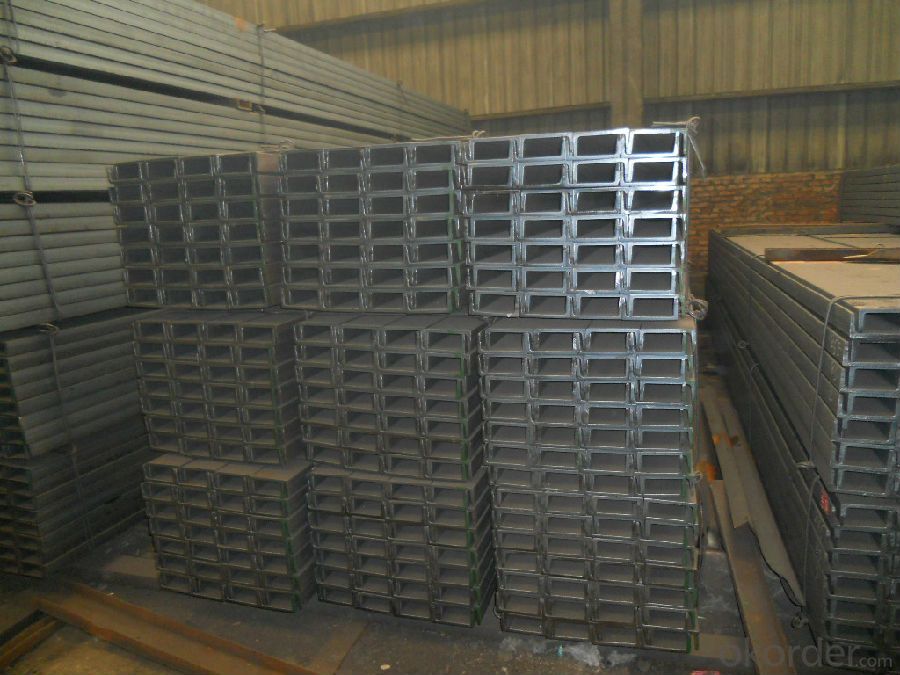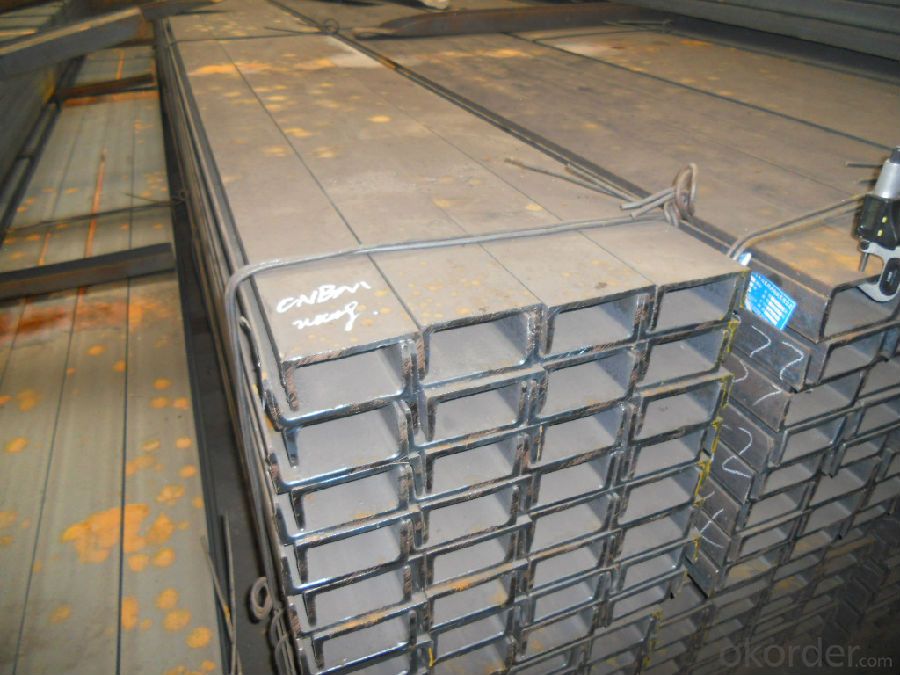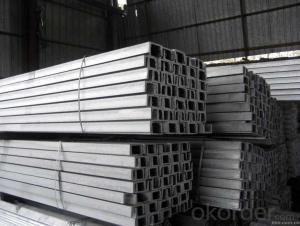JIS SS400 Steel Channel with High Quality 50mm
- Loading Port:
- Tianjin
- Payment Terms:
- TT OR LC
- Min Order Qty:
- 25 m.t
- Supply Capability:
- 10000 m.t/month
OKorder Service Pledge
OKorder Financial Service
You Might Also Like
JIS SS400 Steel Channel with High Quality 50mm
Product Description:
Standard: JIS
Material: SS400
Length: 6m, 12m
Size:
Size (mm) | Mass (Kg/m) |
50*25*3.0 | 2.37 |
Package & Delivery of JIS SS400 Steel Channel with High Quality 50mm:
1.The hot rolled channel steel will be packed in bundle with steel wire at each end of every bundle and color marking in order to help the customer to recognize his goods more easily at sight.
2. And the hot rolled channel steel could be loaded into 20ft or 40ft container, or by bulk cargo.If the weight of each bundle reaches more than 3.5 mt, the loading by break bulk cargo should be choosed.When the weight of each bundle reaches less than 3mt, the loading by container should be choosed.
3.As for the transportaion from mill to loading port, the truck will be usually used. And the maximum quantity for each truck is 40mt.
4.All in all, we could do in accordance with customer's request.
Production Flow of JIS SS400 Steel Channel with High Quality 50mm:
1.The steel billet shall be heated in the high temperature furnace.
2. The heated steel billet shall be rolled five to nine times with the aim of shaping the general figure of steel u channel.
3. The rolled steel channel should be put onto the cooling bed to make the temperature low.
4. The JIS Channel should be straighted on the straightener.
5. The straighted steel u channel will be cut into meters by saw, as per customer's requirements.
6. At the last part of production, the channel steel must be tested in order to confirm that the finished products are completely free from crack, pore, slag, scab or fold on the surface.
FAQ:
Q1: Why buy Materials & Equipment from OKorder.com?
A1: All products offered byOKorder.com are carefully selected from China's most reliable manufacturing enterprises. Through its ISO certifications, OKorder.com adheres to the highest standards and a commitment to supply chain safety and customer satisfaction.
Q2: How do we guarantee the quality of our products?
A2: We have established an advanced quality management system which conducts strict quality tests at every step, from raw materials to the final product. At the same time, we provide extensive follow-up service assurances as required.
Q3: How soon can we receive the product after purchase?
A3: Within three days of placing an order, we will arrange production. The shipping date is dependent upon the quatity, how many sizes you want and the plan of production, but is typically 1 month to 2 month days from the beginning of production.
Images of JIS SS400 Steel Channel with High Quality 50mm:


*If you would like to get our price, please inform us the size, standard/material and quantity. Thank you very much for your attention.
- Q:How do steel channels perform in high-wind areas?
- Steel channels are an excellent choice for structures in high-wind areas due to their strength and durability. Steel is inherently resistant to wind forces and can withstand high winds without significant deformation or failure. The shape of steel channels, which resembles a U or C, also enhances their performance in high winds. The open side of the channel allows wind to pass through, reducing the overall wind load on the structure. This design feature helps minimize the wind-induced pressures, which are particularly important in high-wind areas. Additionally, steel channels are commonly used in conjunction with other structural components, such as beams and columns, to create a robust framework that can withstand the wind's force. These components are often bolted or welded together, providing a strong connection that further enhances the overall performance in high-wind areas. Moreover, steel channels can be fabricated to meet specific project requirements, allowing for customization and optimization of the structural system. This flexibility ensures that steel channels can be engineered and designed to handle the specific wind conditions of a particular location. It is worth noting that the performance of steel channels in high-wind areas also depends on other factors, such as the design of the overall structure, the quality of construction, and adherence to building codes and standards. Proper engineering and construction practices, including appropriate connections and anchoring, are crucial to ensure optimal performance and safety in high-wind areas. In summary, steel channels are highly reliable and effective in high-wind areas due to their inherent strength, shape, and ability to be customized. When properly designed and constructed, steel channels provide a durable and robust solution for structures in regions prone to strong winds.
- Q:Q235's steel plate and channel steel were rusted in the rain. The corrosion is not too serious, but it looks obvious. Will this product be rejected? Is there a standard in this respect?Please answer professionals, thank you.
- Steel plate surface defects are allowed to be cleaned and cleaned, but the minimum thickness of the steel plate shall be ensured. Grinding and cleaning should be smooth, without edges and corners. When welding is required, it shall be carried out according to the provisions of GB/T 14977.
- Q:What are the different types of accessories used with steel channels in construction?
- In construction projects, steel channels commonly utilize various types of accessories. These accessories encompass: 1. Channel nuts, which securely fasten the channel to a support structure. Made of steel, they possess threads for screwing onto the channel. 2. Channel brackets, used to provide extra support to the channel. Usually constructed from steel, they can be affixed to the channel using nuts and bolts. 3. Channel clamps, employed to connect multiple channels together. Particularly useful when longer channel lengths are necessary, ensuring a secure joint. 4. Channel covers, designed to shield the channel from environmental elements like dust, moisture, and debris. Typically crafted from plastic or metal, they effortlessly attach to the channel. 5. Channel hangers, utilized to suspend the channel from a support structure. Composed of steel, they possess a hook or loop on one end for attachment to the support structure. 6. Channel connectors, employed to join two channels at a corner or intersection. Constructed from steel, they can be easily attached to the channels using nuts and bolts. In general, these accessories play a vital role in guaranteeing the stability and functionality of steel channels in construction projects. They offer support, protection, and flexibility, facilitating the efficient installation and utilization of steel channels in diverse applications.
- Q:How do steel channels contribute to ventilation in structures?
- Steel channels can contribute to ventilation in structures by acting as air ducts or conduits, allowing the flow of air from one area to another. These channels can be strategically placed in the structure to ensure proper circulation of fresh air, which is crucial for maintaining a healthy and comfortable indoor environment. Additionally, steel channels can be combined with other ventilation systems, such as fans or vents, to enhance the overall ventilation efficiency of the structure.
- Q:Can steel channels be used in architectural design elements?
- Yes, steel channels can be used in architectural design elements. Steel channels offer strength, durability, and versatility, making them suitable for various applications in architectural designs such as framing, support structures, and decorative elements. They can be incorporated into building facades, staircases, railings, and other architectural features, providing a modern and industrial aesthetic.
- Q:Can steel channels be used in the marine industry?
- Steel channels, also referred to as steel C-channels or structural channels, are applicable in the marine industry. They possess versatility and are extensively utilized in various sectors, including marine applications. These channels are commonly employed for structural support, framing, and reinforcement in marine vessels, offshore platforms, docks, and other related structures. The utilization of steel channels in the marine industry brings forth several advantages. Firstly, steel is a robust and long-lasting material capable of enduring the harsh marine environment, encompassing saltwater exposure, waves, and extreme weather conditions. This quality makes steel channels highly suitable for imparting structural integrity and stability to marine structures. Additionally, steel channels can be readily fabricated and tailored to meet specific design requirements. They can be cut, welded, and formed into diverse shapes and sizes, thus allowing for flexibility in construction and design. This adaptability is essential in the marine industry, where structures must be customized to suit particular applications and specifications. Moreover, steel channels exhibit exceptional load-bearing capacity, rendering them suitable for supporting heavy equipment and loads in the marine industry. They can function as beams, columns, or bracing elements, distributing weight and stresses uniformly, thereby ensuring the safety and stability of marine structures. Furthermore, when properly coated or protected, steel channels display commendable corrosion resistance. This feature is particularly significant in the marine industry where structures are consistently exposed to saltwater, which can expedite corrosion. By employing appropriate coatings or galvanization methods, steel channels can withstand the corrosive impact of seawater, thus prolonging their lifespan and reducing maintenance costs. In conclusion, steel channels are a viable choice for the marine industry due to their strength, durability, versatility, and corrosion resistance. They are widely employed for supporting, framing, and reinforcing marine structures, thereby contributing to the overall safety and longevity of such structures.
- Q:How do steel channels contribute to the overall cost-effectiveness of a project?
- Steel channels contribute to the overall cost-effectiveness of a project in several ways. Firstly, they are lightweight yet strong, allowing for efficient transportation and installation, reducing labor and transportation costs. Secondly, their durability and resistance to corrosion minimize maintenance and replacement expenses over time. Additionally, steel channels are readily available and can be easily fabricated to specific project requirements, eliminating the need for custom-made components and reducing material costs. Overall, the use of steel channels helps optimize project budgets while ensuring long-term structural integrity.
- Q:What are the different grades of steel used in manufacturing channels?
- The different grades of steel used in manufacturing channels can vary depending on the specific application and requirements. Some common grades include A36, A572, and A588. These grades of steel have different properties such as strength, corrosion resistance, and weldability, allowing manufacturers to choose the most suitable grade for their channel manufacturing needs.
- Q:What does channel specification "MQ-41" mean?
- The raw material for producing channel steel is carbon or low alloy steel billets with a carbon content of not more than 0.25%. The finished channel steel is delivered by hot forming, normalizing or hot rolling. The specifications are expressed in millimeters of height (H) * leg width (b) * waist thickness (d), such as 100*48*5.3, which means waist height is 100 mm, leg width is 48 mm, waist thickness is 5.3 mm channel, or 10# channel steel. The same height of the channel, if there are several different leg width and waist thickness, also need to add a, B, C on the right side of the model to distinguish, such as 25#a, 25#b, 25#c and so on.
- Q:What are the different types of steel channel connections for door frames?
- There are several types of steel channel connections commonly used for door frames, including welded connections, bolted connections, and bracket connections. Welded connections involve welding the steel channel directly to the door frame, providing a strong and permanent connection. Bolted connections use bolts and nuts to secure the steel channel to the door frame, allowing for easy disassembly and reassembly if needed. Bracket connections utilize brackets that are attached to both the steel channel and the door frame, providing a secure and adjustable connection. Each type of connection has its advantages and is chosen based on the specific requirements and preferences of the project.
1. Manufacturer Overview |
|
|---|---|
| Location | |
| Year Established | |
| Annual Output Value | |
| Main Markets | |
| Company Certifications | |
2. Manufacturer Certificates |
|
|---|---|
| a) Certification Name | |
| Range | |
| Reference | |
| Validity Period | |
3. Manufacturer Capability |
|
|---|---|
| a)Trade Capacity | |
| Nearest Port | |
| Export Percentage | |
| No.of Employees in Trade Department | |
| Language Spoken: | |
| b)Factory Information | |
| Factory Size: | |
| No. of Production Lines | |
| Contract Manufacturing | |
| Product Price Range | |
Send your message to us
JIS SS400 Steel Channel with High Quality 50mm
- Loading Port:
- Tianjin
- Payment Terms:
- TT OR LC
- Min Order Qty:
- 25 m.t
- Supply Capability:
- 10000 m.t/month
OKorder Service Pledge
OKorder Financial Service
Similar products
New products
Hot products
Related keywords





























